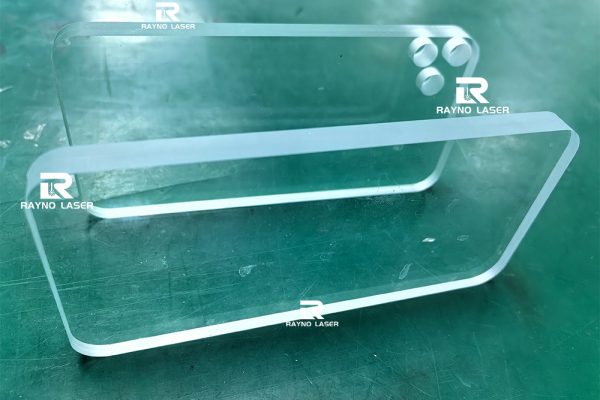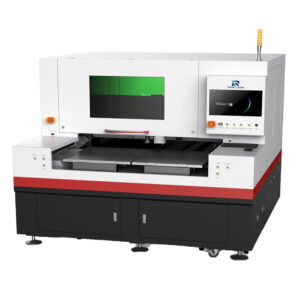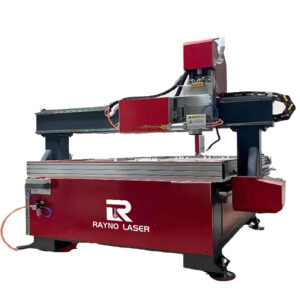Overview
Rayno provides a portfolio of laser glass processing machines to address different budgets, precision needs, thickness ranges, and application scenarios. From high-end picosecond infrared laser cutting machines to cost-effective nanosecond infrared, UV, and green solutions, we help manufacturers achieve the optimal balance of edge quality, throughput, multifunctionality, and investment cost.
Below is a clear, SEO-friendly breakdown of the four primary laser options Rayno currently offers for glass processing.
1) Picosecond Infrared Laser Cutting Machine
Best for: Ultra-smooth edges, fast cutting, high-end production lines
Key strengths
- Extremely smooth edges, virtually no post-processing required.
- High cutting speed, ideal for mass production.
- Typically paired with a CO₂ laser system to split the cut path cleanly (controlled cracking).
Limitations
- Cannot cut holes smaller than 50 mm in diameter.
- High equipment cost—premium solution for premium requirements.
When to choose it:
If your priority is top-tier edge quality, minimal heat-affected zones, and fast throughput—and your budget allows for a higher-end laser—this is the right choice.
2) Nanosecond Infrared Laser Cutting Machine
Best for: Cost-effective, multi-function processing (cutting + drilling + sandblasting + marking)
Key strengths
- Lower price compared to picosecond IR systems.
- Multi-functional: besides cutting, it can drill, sandblast, and mark—a true “one machine, many jobs” solution.
- Edge quality is good for most industrial needs.
Limitations
- Precision and edge finish are not as fine as picosecond IR.
- May require light post-processing for high-spec optical edges.
When to choose it:
If you need versatility and value—and can accept slightly less refined edges than picosecond cutting—this is the most economical and flexible option.
3) Nanosecond UV Laser Device
Best for: Thin glass drilling and cutting
Key strengths
- Shorter wavelength enables higher absorption and finer features on thin, brittle glass.
- Lower heat input, reducing microcracks and edge chipping for thin substrates.
- Ideal for precision drilling and cutting of thin glass (e.g., display panels, cover glass).
Limitations
- Generally not as fast as IR solutions on thicker glass.
- Higher cost than nanosecond IR, but typically less than picosecond IR.
When to choose it:
If your core business involves thin glass with high precision requirements, UV nanosecond is a smart, targeted choice.
4) Nanosecond Green Laser Device
Best for: Micro-drilling, ultra-small apertures
Key strengths
- Capable of drilling holes as small as 0.1 mm diameter.
- Excellent for micro-features and delicate processing where beam focus and absorption are critical.
- A strong complement to other lasers when fine drilling is the bottleneck.
Limitations
- Typically used primarily for drilling, not broad-area cutting.
- Not suited for very high-speed bulk cutting.
When to choose it:
If ultra-small hole drilling (≈0.1 mm) is a core requirement, the green nanosecond laser is the ideal specialized tool.
Quick Comparison Table
| Laser Type | Typical Use Cases | Edge Quality | Hole Capability | Speed | Cost Level | Key Limitation |
|---|---|---|---|---|---|---|
| Picosecond IR Laser Cutting Machine | High-end cutting, premium edge quality | ★★★★★ (ultra-smooth) | ≥ 50 mm apertures | ★★★★★ (very fast) | ★★★★★ (highest) | Cannot drill < 50 mm holes; high price |
| Nanosecond IR Laser Cutting Machine | Cutting + drilling + sandblasting + marking (all-in-one) | ★★★★☆ (good) | Versatile, but not micro-hole focused | ★★★★☆ (fast) | ★★☆☆☆ (affordable) | Edge quality/precision below picosecond IR |
| Nanosecond UV Laser Device | Thin glass drilling & cutting | ★★★★☆ (fine on thin glass) | Small holes on thin substrates | ★★★☆☆ | ★★★☆☆ | Less efficient on thick glass |
| Nanosecond Green Laser Device | Micro-drilling (as small as 0.1 mm) | ★★★★☆ (for drilling tasks) | ≈0.1 mm micro-holes | ★★☆☆☆ | ★★★☆☆ | Mainly for drilling; not ideal for high-speed cutting |
How to Choose the Right Laser Glass Processing Machine
Ask yourself:
- What matters most—edge quality, cost, or versatility?
- Do you need micro-holes (<0.5 mm) or large apertures?
- Are you processing thin or thick glass?
- Is post-processing acceptable, or must the cut be production-ready off the machine?
Typical recommendations:
- Top-edge quality & speed: Picosecond IR + CO₂ splitting.
- Balanced cost & flexibility: Nanosecond IR (cut, drill, sandblast, mark).
- Thin glass precision: Nanosecond UV.
- Micro-drilling (down to 0.1 mm): Nanosecond Green.



